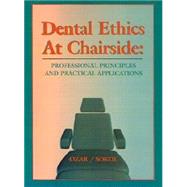Originally published by Mosby in 1994.

Originally published by Mosby in 1994.
| PART ONE THE DENTAL PROFESSION AND PROFESSIONAL ETHICS | |||||
|
1 | (7) | |||
|
1 | (1) | |||
|
2 | (1) | |||
|
3 | (1) | |||
|
3 | (1) | |||
|
4 | (1) | |||
|
5 | (1) | |||
|
5 | (1) | |||
|
6 | (1) | |||
|
6 | (2) | |||
|
8 | (15) | |||
|
11 | (1) | |||
|
12 | (2) | |||
|
14 | (3) | |||
|
17 | (2) | |||
|
19 | (1) | |||
|
20 | (3) | |||
|
23 | (13) | |||
|
26 | (1) | |||
|
27 | (1) | |||
|
28 | (3) | |||
|
31 | (5) | |||
|
36 | (19) | |||
|
37 | (1) | |||
|
38 | (7) | |||
|
45 | (4) | |||
|
49 | (2) | |||
|
51 | (4) | |||
|
55 | (20) | |||
|
56 | (3) | |||
|
59 | (5) | |||
|
64 | (5) | |||
|
69 | (6) | |||
|
75 | (26) | |||
|
78 | (1) | |||
|
78 | (2) | |||
|
80 | (5) | |||
|
85 | (1) | |||
|
86 | (1) | |||
|
87 | (1) | |||
|
88 | (3) | |||
|
91 | (10) | |||
| PART TWO ETHICAL ISSUES IN DENTAL PRACTICE | |||||
|
101 | (20) | |||
|
102 | (2) | |||
|
104 | (2) | |||
|
106 | (6) | |||
|
112 | (6) | |||
|
118 | (3) | |||
|
121 | (13) | |||
|
124 | (2) | |||
|
126 | (1) | |||
|
127 | (1) | |||
|
128 | (1) | |||
|
129 | (2) | |||
|
131 | (3) | |||
|
134 | (31) | |||
|
135 | (2) | |||
|
137 | (3) | |||
|
140 | (2) | |||
|
142 | (8) | |||
|
150 | (2) | |||
|
152 | (1) | |||
|
153 | (1) | |||
|
153 | (3) | |||
|
156 | (5) | |||
|
161 | (4) | |||
|
165 | (23) | |||
|
168 | (2) | |||
|
170 | (2) | |||
|
172 | (4) | |||
|
176 | (1) | |||
|
177 | (5) | |||
|
182 | (6) | |||
|
188 | (17) | |||
|
189 | (1) | |||
|
190 | (4) | |||
|
194 | (2) | |||
|
196 | (2) | |||
|
198 | (4) | |||
|
202 | (3) | |||
|
205 | (14) | |||
|
206 | (4) | |||
|
210 | (3) | |||
|
213 | (1) | |||
|
213 | (1) | |||
|
214 | (2) | |||
|
216 | (3) | |||
|
219 | (15) | |||
|
220 | (1) | |||
|
221 | (2) | |||
|
223 | (3) | |||
|
226 | (2) | |||
|
228 | (2) | |||
|
230 | (4) | |||
|
234 | (21) | |||
|
236 | (2) | |||
|
238 | (6) | |||
|
244 | (2) | |||
|
246 | (2) | |||
|
248 | (7) | |||
|
255 | (2) | |||
|
257 | (3) | |||
|
260 | (3) | |||
|
263 | (1) | |||
|
264 | (1) | |||
|
265 | (1) | |||
|
265 | (1) | |||
|
266 | (2) | |||
|
268 | (2) | |||
|
270 | ||||
| Appendix Bibliographic Essay |
The New copy of this book will include any supplemental materials advertised. Please check the title of the book to determine if it should include any access cards, study guides, lab manuals, CDs, etc.
The Used, Rental and eBook copies of this book are not guaranteed to include any supplemental materials. Typically, only the book itself is included. This is true even if the title states it includes any access cards, study guides, lab manuals, CDs, etc.